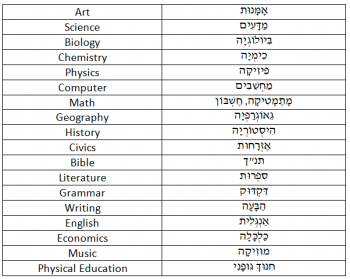The Israeli School Year Posted by Ayana on Aug 26, 2019 in Uncategorized
School year (שְׁנַת הַלִּמּוּדִים) in Israel opens on September 1st.
More than 2 million students aged 3-18 will wake up next week to the first day of שְׁנַת הַלִּמּוּדִים תש”פ. School year in Israel opens every year on September 1st according to the Gregorian calendar, but named according to the Jewish calendar. The month of September usually overlaps with Tishrei, the first month in the Hebrew calendar. This year, for example, the Jewish New Year is celebrated on September 29th. Therefore, every school year is named after the Jewish new year that begins around the same time. This year is שְׁנַת תש”פ, and the school year is called שְׁנַת הַלִּמּוּדִים תש”פ.
The law in Israel asserts that enrolling into an educational institute is mandatory for children from age 3 to 18. Every child at age 3-6 must attend kindergarten (גַּן יְלָדִים, or in short גַּן), every child at age 6-12 must attend elementary school (בֵּית סֵפֶר יְסוֹדִי, or in short יְסוֹדִי), every child at age 12-18 must attend high school (בֵּית סֵפֶר תִּיכוֹן, or in short תִּיכוֹן). The six years of high school are divided to two. The first three years are called junior high school (חֲטִיבַת בֵּינַיִם, or in short חֲטִיבָה). The last three years are called high school. Very few students enroll to another high school after finishing the first three years. A more formal name that includes both junior high school and high school is בֵּית סֵפֶר עַל-יְסוֹדִי (post-primary school).

The Israeli education institutions distinguish the different school years alphabetically, rather than with numbers. Every year is called כִּתָּה. The word כִּתָּה means both grade and classroom (the actual room), but it’s easy to distinguish between the two meanings by the context. The first year goes by the first letter in the Hebrew alphabet – כִּתָּה א’. The second year goes by the second letter, and so on: כִּתָּה ב’, כִּתָּה ג’. For graduating up to the next grade we simply use the verb לַעֲלוֹת (meaning to go up, to rise, to ascend, conjugated according to binyan pa’al). For example:
אֵיךְ הַהַרְגָּשָׁה לַעֲלוֹת לְכִּתָּה ו’?
How does it feel to move up to sixth grade?
רֹב הַתַּלְמׅידׅים עוֺלׅים כִּתָּה בְּהַצְלָחָה, רַק מְעַטּׅים נֶאֱלָצִים לְהִשָּׁאֵר עוֺד שָׁנָה.
Most students move up successfully, only a few need to stay back.
To describe which grade you are, we use the preposition בְּ (in, at). For example: אֲנִי בְּכִּתָּה ח’ (I’m in eighth grade). But this is true only during the school year long.
The Israeli School year lasts ten months. It ends in June. גַּנֵי הַיְּלָדִים וּבָתֵּי הַסֵּפֶר הַיְּסוֹדִיּׅים end the school year on June 30th; בָּתֵּי הַסֵּפֶר הָעַל-יְסוֹדִיּׅים end the school year on June 20th. Students and teachers enjoy only short vacations during holidays, fasts, memorial days, etc. The one long vacation is summer vacation, lasts two months from July through August, and is called in Hebrew הַחֹופֶשׁ הַגָּדוֹל (literally the big vacation). During the vacation a student doesn’t belong to any grade. He can’t say I’m in… But he can use the verb לַעֲלוֹת. During summer vacation, students use the preposition לְ (to, toward) to describe which grade they are moving into. For example: אֲנִי עוֺלֶה לְכִּתָּה ט’ (I’m moving up to ninth grade).
These are the school subjects Israeli students learn:

Text vocabulary
School year = שְׁנַת הַלִּמּוּדִים
Kindergarten = גַּן יְלָדִים (or in short גַּן)
Elementary school = בֵּית סֵפֶר יְסוֹדִי (or in short יְסוֹדִי)
High school = בֵּית סֵפֶר תִּיכוֹן (or in short תִּיכוֹן), בֵּית סֵפֶר עַל-יְסוֹדִי
Junior high school = חֲטִיבַת בֵּינַיִם (or in short חֲטִיבָה)
Grade = כִּתָּה
Classroom = כִּתָּה
Student = תַּלְמׅיד
To move a grade up = לַעֲלוֹת כִּתָּה
To stay back a grade = לְהִשָּׁאֵר כִּתָּה
Summer vacation = הַחֹופֶשׁ הַגָּדוֹל
Keep Calm and Learn Hebrew!

Build vocabulary, practice pronunciation, and more with Transparent Language Online. Available anytime, anywhere, on any device.




